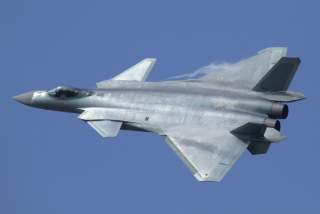China's Air Force Is Becoming Very Powerful (But Suffers from One Super Fatal Flaw)
Russia's Su-35 might be the last jet China purchases from Moscow...if they can build their own engines.
Will the Sukhoi Su-35 Flanker-E be the last jet fighter that China imports? The Chinese government’s official media certainly seems to believe so. “With the commissioning of the J-20, the Su-35 will soon lose its value in the Chinese market,” the People’s Daily states.
It is certainly possible that the advanced Russian-made jet will be the last fighter aircraft that Beijing imports, however, China will likely be dependent on Russia for subsystems such as engines for some time to come. Beijing has made tremendous progress with developing its own combat aircraft and the avionics needed to equip those machines, but China continues to be hampered by its inability to develop and produce reliable jet engines.
Indeed, China has demonstrated progress with developing not only stealthy new airframes such as the J-20 and the FC-31, but also seemingly with the active electronically scanned array (AESA) radars, electro-optical/infrared sensors and electronic warfare systems, data-links and even the cockpit displays that are typical of fifth-generation fighters.
At the Zhuhai airshow last November, the Shenyang Aircraft Corporation exhibited a video of the FC-31 showing off capabilities such as a distributed aperture system (DAS) and an electro-optical targeting system (EOTS) similar to those mounted on the Lockheed Martin F-35 Joint Strike Fighter. The aircraft is also reputed to feature a KLJ-7A AESA radar that is being developed by the Nanjing Research Institute of Electronics Technology.
However, it remains to be seen if China has come close to mastering “sensor fusion”—which is to tie all of those myriad sensor and data feeds into a single coherent picture. That’s a capability found onboard the Lockheed Martin F-22 Raptor and F-35, but it has taken years of effort and billions of dollars to master (and in the case of the F-35, it’s still a work in progress). Beijing will eventually get there in time, but it’s hard to say how long that will take.
Engines, however, continue to remain a weak spot for Chinese industry. But jet engines are inherently difficult to develop and produce. Indeed, only a handful of advanced industrial nations have the technological capacity to independently develop and build their own working and producible jet engines—the United States, Russia, France, Great Britain, Germany and Japan. Almost every other power is dependent on others to develop propulsion technology.
China is determined to close that gap, but it has not yet succeeded in doing so. Last year, Beijing setup the Aero Engine Corp. of China (AECC) as part of its efforts to solve the problem. The firm has $7.5 billion in capital and 96,000 employees. According to a CNN report, Beijing's most recent five-year development plan states that developing and producing indigenous engines is one of China’s most important goals.
China has the money and the willpower to develop its own aerospace engine industry. It’s just a matter of time before Beijing masters jet engine technology and starts developing and mass-producing its own propulsion systems. When that day comes, China will be independent of Russian engine technology and might indeed become a major aerospace industrial power in its own right.
Dave Majumdar is the defense editor for The National Interest. You can follow him on Twitter: @davemajumdar.
Image Credit: Creative Commons.

